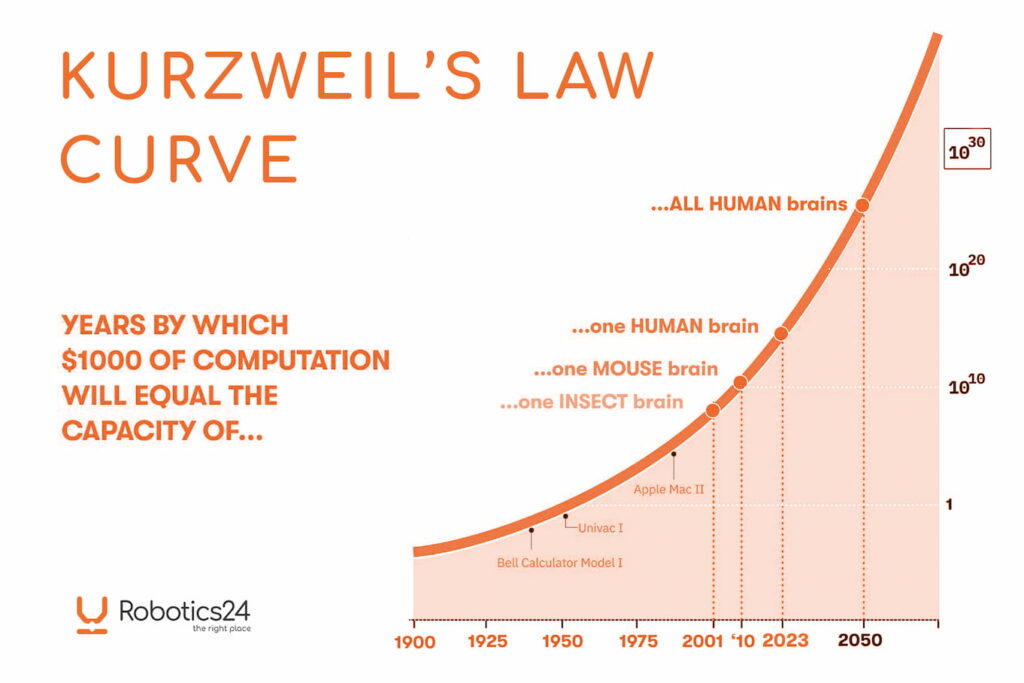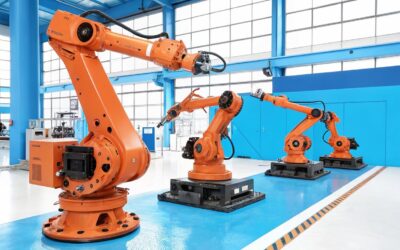- The rate of technological progress and innovation tends to accelerate exponentially over time.
- Advancements in various domains, particularly in the fields of information technology, artificial intelligence, and biotechnology, occur at an increasingly rapid pace.
- This acceleration leads to an exponential growth pattern, where new technologies build upon previous ones, resulting in significant advancements within shorter timeframes.

Synonyms
Law of Accelerating Returns – Exponential Growth Principle
Antonyms
Linear Growth Model – Steady-State Hypothesis
Etymology
The term “Kurzweil’s Law of Accelerating Returns” is named after its proponent, Ray Kurzweil, who first introduced the concept in his book “The Singularity is Near: When Humans Transcend Biology” published in 2005.
Kurzweil is a prominent futurist, inventor, and author known for his predictions and analysis of exponential technological growth.
Pronunciation
KURZ-wilez Law of Aksel-uh-rey-ting Re-turns
/ˈkɜːrzwaɪlz lɔː/
Related Terms
Singularity – Moore’s Law – Exponential growth – Technological convergence
Quotations
“Kurzweil’s Law of Accelerating Returns suggests that the next few decades will witness technological advancements equivalent to what previously took centuries.”
Ray Kurzweil, The Singularity is Near, 2005
“We won’t experience 100 years of progress in the 21st century—it will be more like 20,000 years of progress (at today’s rate).”
Ray Kurzweil
“Kurzweil’s Law of Accelerating Returns has been a subject of debate and discussion among scientists, technologists, and futurists, shaping the understanding of our technological future”
Future Studies Quarterly, Vol. 28, Issue 1, 2018
Fields of Application
Kurzweil’s Law of Accelerating Returns has implications for various fields and industries, including:
- Information technology: The law has been observed in the exponential growth of computing power, data storage, and network capabilities.
- Artificial intelligence: Advancements in AI algorithms, machine learning, and deep learning techniques align with Kurzweil’s Law, enabling more sophisticated AI systems.
- Biotechnology: The rapid progress in genetic engineering, regenerative medicine, and personalized healthcare aligns with the predictions of accelerating returns.
- Robotics: The development of robotics and automation technologies is greatly influenced by the exponential growth patterns predicted by Kurzweil’s Law.
- Energy: The adoption and advancement of renewable energy technologies, energy storage, and efficiency improvements are driven by the principles of accelerating returns.
Example Sentences
“According to Kurzweil’s Law of Accelerating Returns, the processing power of computers doubles approximately every two years.”
“The exponential growth in the field of nanotechnology aligns with Kurzweil’s Law, leading to breakthroughs in materials science and miniaturized devices.”
“The application of Kurzweil’s Law in the field of robotics has led to significant advancements in autonomous systems, human-robot interaction, and industrial automation.”
Curiosities
- Kurzweil’s Law of Accelerating Returns has been met with both enthusiasm and skepticism. Some argue that while progress may be exponential in certain domains, it may not apply universally.
- Ray Kurzweil has made several predictions based on his Law of Accelerating Returns, including the emergence of strong AI, life extension technologies, and the achievement of technological singularity by the mid-21st century.
- The exponential growth predicted by Kurzweil’s Law has implications for societal and ethical considerations, requiring careful examination and proactive measures to ensure responsible development and deployment of technologies.
Analogies
Snowball
Kurzweil’s Law of Accelerating Returns is similar to a rolling downhill, where its size and speed increase rapidly as it picks up more snow along the way.
Compound Interest in Finance
Just as compound interest leads to exponential growth in investments, Kurzweil’s Law suggests exponential growth in technology.
Frequently Asked Questions
Is Kurzweil’s Law of Accelerating Returns universally accepted?
The concept has sparked discussions and debates among scientists and experts, with varying degrees of agreement and skepticism.
Can Kurzweil’s Law be applied to all areas of technology?
While the law is often observed in fields like information technology and AI, its applicability to all domains remains a topic of discussion.
How does Kurzweil’s Law impact society?
Kurzweil’s Law suggests that rapid technological advancements can have profound effects on various aspects of society, including the economy, employment, and ethics.
Is there evidence supporting Kurzweil’s Law?
There are historical trends and data that support the exponential growth of technologies like computing power, data storage, and network capacity, which align with Kurzweil’s Law.
Does Kurzweil’s Law consider potential limitations or constraints on technological progress?
Critics argue that there may be physical, economic, or societal constraints that could hinder the fulfillment of Kurzweil’s predictions, suggesting that the law’s application requires careful analysis.
Read also Singularity theory



